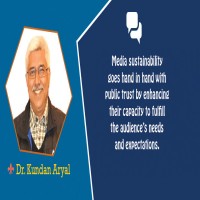Redefining Media Sustainability
Dr. Kundan Aryal
Nepali media landscape has undergone a sea change for more than a century. In the aftermath of the first dawn of democracy in 1951, the country also entered an era of independent journalism. In 1990, another benchmark was created for media sustainability with the proliferation of big dailies and wider diversity in the broadcasting sector. However, the debate on the issue of sustainability is yet to gain wider currency.
Grishma Bahadur Devkota, a well-known media historian, states that the country's first daily Aawaj, which started with the proclamation of democracy in 1951, was shut down after the publication of its 107th issue. He has chronicled the history of all Nepali newspapers of that period. Tek Bahadur Khatri, in his monograph entitled ‘Nepal's Mass Media’, describes the post-1951 media scenario. The monograph was published in 1983. The United Nations' General Assembly had proclaimed 1983 as World Communications Year: Development of Communications Infrastructures.
Media growth
Khatri states that the common people felt the need for more and more newspapers to raise their voice for justice, liberty and national development following the 1951 political change. Consequently, the number of newspapers and magazines increased. They served as a viable platform for the public to air their genuine concerns. The political culture was also conducive to the development of journalism. Up to 1960, the Nepali journalism, especially the print media, continued to proliferate. The removal of elected government in 1960 put a sudden brake on the growth of newspapers. Restrictive laws and regulations were enacted to suppress the press freedom. In April 1990, the country again obtained free press that unleashed a rapid transformation in the media landscape. This encouraged the rise of large-scale newspapers under corporate management, promoting a diversity of perspectives.
During the periods between 1951 and 1960, and between 1960 and 1990, the issue of media sustainability used to be defined primarily in terms of the longevity of newspapers. With the 1990 democratic movement bringing changes to the country’s socio-economic status, media sustainability has now encompassed wider meaning. In terms of the scale of investment, audience access, job market, and impact on society, the Nepali media has sustained in comparison to the pre-1990 period. However, media sustainability should not be defined now merely on the basis of their durability or the business size of a few media houses. Quest for media sustainability needs to be understood in the context of their existence and functioning as reliable, independent and professional institutions. Media sustainability needs to be defined in terms of their proliferation and capability to respect public aspirations.
Nepali audience needs pluralistic and diverse media contents that enable to consolidate democracy and cultivate proactive roles of media for good governance. People prefer media outlets that are easily accessed or convenient. Apart from the technical aspect, there are a number of dimensions pertinent to creating a sustained media atmosphere in the longer term. In the post-COVID-19 phase, the Nepali media audience has been rapidly shifting from traditional media to digital ones. Thus, all the content producers need to be updated to ensure sustainability.
Nepali media suffer from dual problems. On one hand, there is a weak financial base and inadequate investment in content development while there is a visible symptom of hyper commercialisation in the media realm, on the other. Likewise, inadequacy in addressing the issue of inclusiveness could also hamper to gain greater public trust. Failure to cater to the needs of young, educated and growing active population, there can be a shift of audience from domestic to the regional and global media. Over politicisation of content and partisan coverage may fuel the trend.
Socialisation of media
Socialisation of media people, which includes media education, training and empirical research, is equally crucial. To make a media outlet fair, a visible editorial policy and ethical guidelines, developed by individual media outlets, play an important role. Since the representativeness of news content is undoubtedly affected by journalists' conceptions of which events and people are most newsworthy, such policy or guidelines would be effective tools for professional performance and balance. Infrequent and low substantial media coverage of issues concerning people's day-to-day life will result in low public enthusiasm for the media. Hence, media persons need to be socialised, capacitated and sensitised to ensure substantial and effective coverage of diverse socio-political and economic issues.
As Marshall T. Poe states in his book ‘A History of Communications: Media and Society from the Evolution of Speech to the Internet,’ Nepal also has witnessed changes in three major spheres -- medium attributes, network attributes, and social practices and values. Access to the media has widened and the entire society has undergone the influence of mediated communication. The Nepali media have been instrumental in disseminating, storing and retrieving information. However, they could escalate their dependability in a sustained way by augmenting the degree of trust.
In the given socio-political and economic atmosphere, survival of dependable and trustworthy media outlets would not be difficult. Media sustainability goes hand in hand with public trust by enhancing their capacity to fulfill the audience’s needs and expectations.
(Dr. Aryal is associated with the Central Department of Journalism and Mass Communication of Tribhuvan University.)
Recent News

Do not make expressions casting dout on election: EC
14 Apr, 2022
CM Bhatta says may New Year 2079 BS inspire positive thinking
14 Apr, 2022
Three new cases, 44 recoveries in 24 hours
14 Apr, 2022
689 climbers of 84 teams so far acquire permits for climbing various peaks this spring season
14 Apr, 2022
How the rising cost of living crisis is impacting Nepal
14 Apr, 2022
US military confirms an interstellar meteor collided with Earth
14 Apr, 2022
Valneva Covid vaccine approved for use in UK
14 Apr, 2022
Chair Prachanda highlights need of unity among Maoist, Communist forces
14 Apr, 2022
Ranbir Kapoor and Alia Bhatt: Bollywood toasts star couple on wedding
14 Apr, 2022
President Bhandari confers decorations (Photo Feature)
14 Apr, 2022











